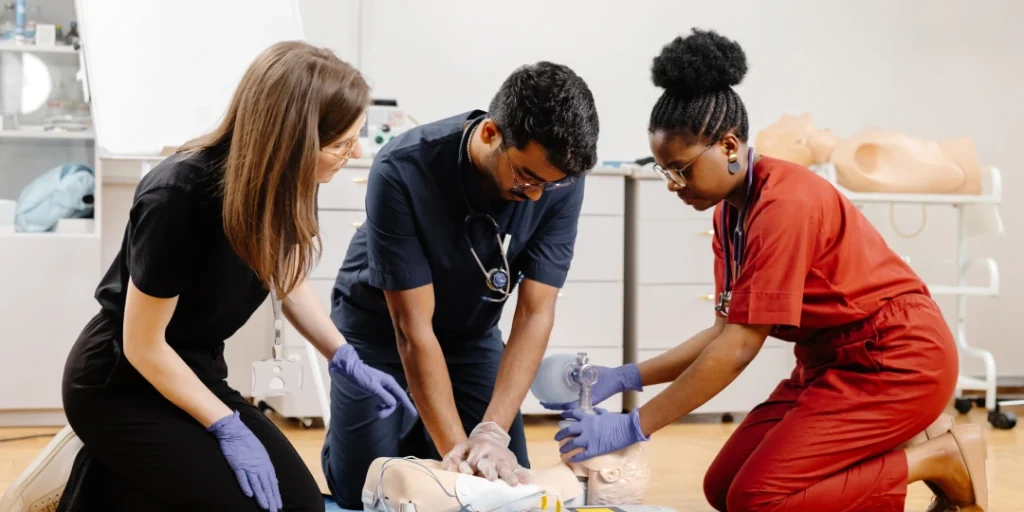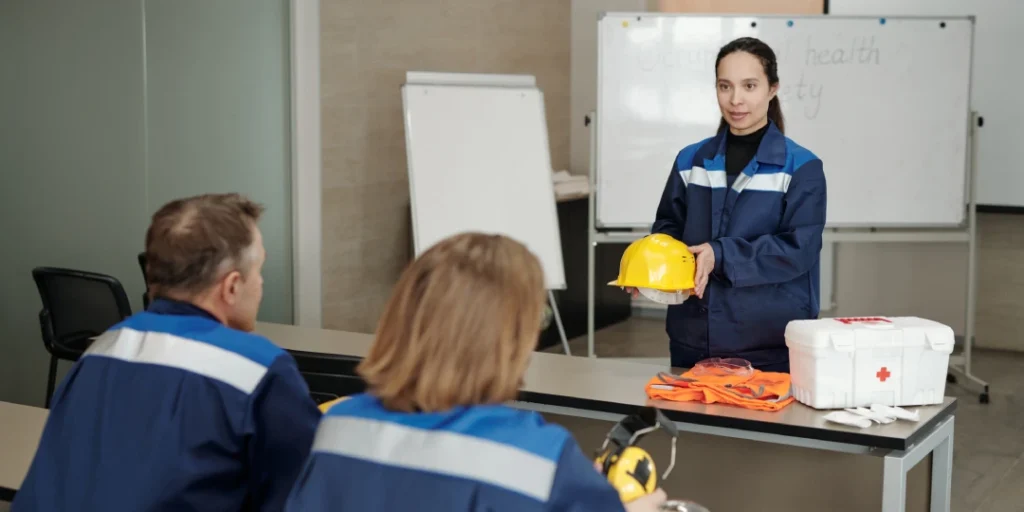The Vital Importance of First Aid & CPR Training
Emergencies strike without warning, and the capacity to respond with composure can redefine outcomes in the most critical moments. First Aid and CPR certification is far more than a rudimentary skill—it is a transformative paradigm that empowers individuals to act decisively under pressure. When a heart stops or an airway becomes obstructed, immediate intervention can be the decisive factor between life and death. This training imparts not only the technical knowledge needed to administer life-saving techniques but also the confidence to execute them amid chaos.
In the vital minutes following an emergency, a trained responder becomes the linchpin in the chain of survival. The curriculum encompasses a broad spectrum of emergency interventions, from performing high-quality chest compressions during cardiac arrest to adeptly managing choking incidents. Such preparedness is crucial, as the window for effective intervention is invariably narrow. The certification process, therefore, instills a heightened sense of readiness and responsibility, ensuring that every second is optimized until professional medical assistance arrives. By mastering these essential techniques, individuals contribute significantly to community resilience, fostering a safer environment for all.
Why Nashville Businesses and Individuals Need CPR Certification
In a vibrant metropolis like Nashville, where the pulse of the city is both dynamic and unrelenting, the necessity for CPR certification extends to every corner of the community. From corporate boardrooms and educational institutions to bustling restaurants and expansive construction sites, the potential for emergencies is omnipresent. Tennessee law mandates CPR certification for certain professionals, underscoring its importance; however, the practical benefits resonate far beyond regulatory compliance.
Every setting in Nashville, whether a high-rise office or a community school, benefits from having individuals who are adept in emergency response. In an environment where a sudden cardiac arrest or a severe injury can occur at any time, the presence of a certified responder can drastically enhance survival prospects. The critical nature of rapid intervention means that trained bystanders play a pivotal role in mitigating the severity of injuries and, in many cases, preventing fatalities.
CPR certification is not merely an individual accolade but a communal asset—a testament to civic responsibility. When businesses invest in comprehensive emergency training programs, they not only comply with legal requirements but also fortify their commitment to the well-being of employees, clients, and the larger public. This proactive approach cultivates a culture of vigilance and preparedness, ensuring that Nashville remains a city where safety is paramount. In such a dynamic urban landscape, the integration of First Aid and CPR training within everyday practice is indispensable, ultimately weaving a resilient safety net across the community.
What Sets Fortier Loss Control Apart in Emergency Training
Fortier Loss Control distinguishes itself through a blend of experiential rigor and a tailored, immersive training approach. Unlike impersonal online modules that merely skim the surface, their programs engage participants in dynamic, hands-on scenarios that simulate the exigencies of real emergencies. The instructors, steeped in practical expertise, integrate real-world case studies with interactive exercises, ensuring that each trainee is not only versed in the fundamentals but also adept at adapting to unforeseen challenges. This immersive methodology cultivates a robust confidence and a perspicacious understanding of emergency response, making every session a transformative learning experience. The focus is on fostering quick decision-making, dexterity, and resilience—qualities indispensable in moments when every second is critical.

Understanding the Basics: What First Aid & CPR Certification Covers
A comprehensive First Aid & CPR course at Fortier Loss Control is designed to build a solid foundation in emergency medical response. The curriculum is meticulously structured to cover an array of life-saving techniques, ensuring that participants are well-equipped to manage diverse medical emergencies. Key components include:
- CPR Techniques: Mastery of chest compressions and rescue breaths tailored to adults, children, and infants ensures that practitioners can respond adeptly across age groups.
- Automated External Defibrillator (AED) Operation: Understanding the operational intricacies of AEDs empowers trainees to revive cardiac function swiftly.
- Choking Relief Procedures: Detailed protocols for alleviating airway obstructions are essential for managing life-threatening incidents.
- Bleeding Control and Wound Care: Methods for staunching hemorrhages and managing lacerations are critical for stabilizing patients in the immediate aftermath of trauma.
- Management of Burns, Fractures, and Head Injuries: Fundamental care procedures for various injuries prepare participants to deliver prompt and effective intervention.
- Recognition of Stroke and Heart Attack Symptoms: Early identification of critical symptoms ensures that patients receive timely and appropriate care.
These foundational skills are presented through a synthesis of theoretical instruction and practical application, enabling participants to translate knowledge into effective action when circumstances demand swift, precise responses.
Advanced Techniques and Life-Saving Skills Taught in the Course
Beyond the basics, Fortier Loss Control delves into advanced methodologies that enhance the efficacy of emergency interventions. Their training modules incorporate sophisticated techniques that cater to more complex scenarios, ensuring that trainees are prepared to operate under the most challenging conditions. Among these advanced skills are:
- Two-Rescuer CPR: This technique emphasizes the synergy between team members, where coordinating chest compressions and rescue breaths can substantially elevate the quality of care. Training in two-rescuer CPR reinforces the importance of collaboration and precise timing, which can be pivotal during critical emergencies.
- Rescue Breathing Techniques: The course provides an in-depth exploration of rescue breathing protocols designed for situations where the victim maintains a pulse yet struggles to breathe independently. Mastery of these techniques ensures the continuous delivery of oxygen until further assistance arrives.
- Shock Management: Recognizing and mitigating various forms of shock—such as hypovolemic or anaphylactic shock—forms a crucial component of the advanced curriculum. Trainees learn to stabilize victims through rapid assessment and the application of targeted interventions, preserving vital organ function during critical periods.
- Environmental Emergencies: Specialized training modules address the unique challenges presented by environmental emergencies, including hypothermia, heatstroke, and poisoning. By simulating conditions that replicate real-world scenarios, the course equips participants with the versatility to manage emergencies that occur in diverse settings.
Through this multifaceted approach, Fortier Loss Control ensures that its participants are not only proficient in standard life-saving techniques but are also capable of navigating complex emergencies with agility and expertise. The advanced training provided serves as a catalyst for cultivating a resilient, adaptive mindset—essential attributes for any effective first responder.
Who Should Get Certified? From Professionals to Parents
CPR and First Aid certification extends far beyond the realm of healthcare professionals. The ability to respond effectively in an emergency is a skill that holds immense value across various professions and everyday life. At Fortier Loss Control, the training is designed to benefit individuals from all walks of life, ensuring that more people are equipped to act decisively when faced with life-threatening situations. Those who stand to gain the most from certification include:
- Teachers and Childcare Providers – With young children prone to choking, falls, and sudden illnesses, educators and caregivers must be prepared to administer immediate care before medical personnel arrive.
- Fitness Trainers and Coaches – Sports-related injuries, dehydration, and sudden cardiac events make First Aid and CPR training indispensable for professionals overseeing physically active individuals.
- Construction Workers and Industrial Employees – High-risk work environments present hazards such as falls, electrocution, and equipment-related injuries, necessitating swift and effective intervention.
- Parents and Caregivers – Emergencies can happen at home, and parents who are trained in CPR and First Aid can provide immediate care to their children or elderly family members when every second counts.
- Corporate Professionals – Large office settings may not seem hazardous, but medical emergencies such as heart attacks, strokes, or choking incidents can arise unexpectedly, making trained employees invaluable in critical moments.
By obtaining CPR and First Aid certification, individuals across these various professions and lifestyles contribute to a safer environment, ensuring that help is always within reach when needed most.

The Hands-On Training Experience at Fortier Loss Control
While theoretical knowledge is essential, real proficiency in CPR and First Aid comes from hands-on practice. Fortier Loss Control places a strong emphasis on experiential learning, ensuring that participants gain confidence through direct engagement with life-saving techniques.
Trainees work with state-of-the-art manikins that provide real-time feedback on compression depth and ventilation efficacy, ensuring precision in execution. Advanced training tools simulate real-life medical emergencies, allowing individuals to perfect chest compressions, master AED operation, and practice bleeding control techniques under the guidance of experienced instructors.
The incorporation of simulated emergency drills further reinforces the learning experience, placing participants in high-pressure scenarios where split-second decision-making is required. By creating a controlled yet realistic environment, Fortier Loss Control ensures that each trainee leaves the course with not just theoretical understanding, but the muscle memory and confidence to act decisively in real emergencies.
CPR Certification Requirements and Renewal Guidelines
Becoming certified in CPR and First Aid is not a one-time endeavor. The medical field is constantly evolving, with updated guidelines and techniques introduced periodically to enhance survival rates and improve emergency response protocols. For this reason, CPR certification has a limited validity period, typically lasting two years before renewal is required.
Fortier Loss Control offers streamlined recertification programs that allow individuals to refresh their knowledge and refine their skills efficiently. These courses cover the latest updates in compression-to-ventilation ratios, AED advancements, and new recommendations for emergency care best practices. Regular recertification ensures that trained individuals remain competent, confident, and compliant with current safety standards.
By maintaining an active certification, professionals, caregivers, and workplace safety leaders ensure they are always prepared to provide the most effective assistance when it matters most. Whether obtaining certification for the first time or renewing existing credentials, Fortier Loss Control provides a comprehensive, hands-on learning experience that equips individuals with the necessary tools to respond to medical emergencies with precision and confidence.
The Role of First Aid & CPR in Workplace Safety Compliance
For businesses, First Aid and CPR certification is not just a precaution—it is a critical compliance requirement. Regulatory bodies such as OSHA (Occupational Safety and Health Administration) mandate that workplaces, especially those with higher occupational risks, have designated employees trained in emergency response. Compliance with these standards is not just about fulfilling legal obligations; it plays a pivotal role in workplace safety, liability reduction, and overall emergency preparedness.
Industries such as construction, manufacturing, healthcare, hospitality, and education face a heightened risk of workplace injuries and medical emergencies. By investing in Fortier Loss Control’s First Aid and CPR training programs, businesses in Nashville can ensure they meet OSHA requirements while cultivating a culture of proactive safety and employee well-being. A workforce trained in life-saving techniques can mitigate risks, reduce response time in emergencies, and potentially save lives before paramedics arrive.
Additionally, businesses that prioritize emergency preparedness often experience lower insurance premiums, reduced legal exposure, and enhanced employee confidence. Training programs do not just benefit the workplace—they empower employees with skills that extend into their daily lives, ensuring they are prepared to respond effectively to emergencies anywhere.
How First Aid & CPR Training Saves Lives in Real Emergencies
The true significance of First Aid and CPR certification is most evident in real-world emergencies. Sudden medical crises, whether in the workplace, home, or public settings, can escalate rapidly without immediate intervention. However, trained individuals can dramatically improve survival rates through quick, informed action.
Consider these life-saving statistics:
- A cardiac arrest victim’s survival rate doubles or triples if CPR is administered within the first few minutes.
- Choking deaths are preventable with proper Heimlich maneuver training, ensuring swift airway clearance.
- Severe allergic reactions (anaphylaxis) can be managed with rapid administration of an epinephrine auto-injector.
- Traumatic injuries from accidents, falls, or workplace incidents can be stabilized, reducing complications before professional medical care arrives.
When individuals possess the knowledge and confidence to act, they transform from bystanders into first responders. Whether in a Nashville office, construction site, school, or public venue, the presence of a CPR and First Aid-certified individual can mean the difference between life and death.

Frequently Asked Questions

Conclusion
Preparedness is power. In today’s unpredictable world, CPR and First Aid certification is more than a credential—it is a vital investment in personal and communal resilience. Equipped with these life-saving skills, individuals transform into confident, capable first responders, ready to act decisively during the critical moments when every second counts. The expertise gained through Fortier Loss Control’s hands-on training is meticulously honed to ensure that professionals, parents, and community members alike can deliver precise, efficient care during emergencies.
Fortier Loss Control’s expert-led courses blend theoretical instruction with practical application, fostering a deep understanding of both basic and advanced emergency procedures. This dynamic approach instills not only the technical proficiency required to handle complex medical scenarios but also the confidence to overcome hesitation in high-pressure situations. Such readiness is indispensable in settings ranging from bustling workplaces to the intimate environment of one’s home, where the ability to administer timely care can markedly improve outcomes.
Beyond fulfilling regulatory mandates and enhancing workplace safety protocols, obtaining CPR and First Aid certification underscores a broader commitment to community well-being. It reflects an awareness that safeguarding lives is a shared responsibility—a pledge to act when it matters most. Whether mitigating the risks associated with everyday hazards or confronting unforeseen crises, those who are trained embody the spirit of proactive care, ensuring that vital assistance is never out of reach.
In a world where uncertainty is inevitable, being prepared with life-saving skills is the most effective countermeasure to tragedy. The empowerment derived from such training resonates far beyond the individual; it fortifies entire communities and nurtures a culture of resilience. Ultimately, knowledge of emergency response is a beacon of hope—a steadfast reminder that when equipped with the right skills, every life has the potential to be saved.



